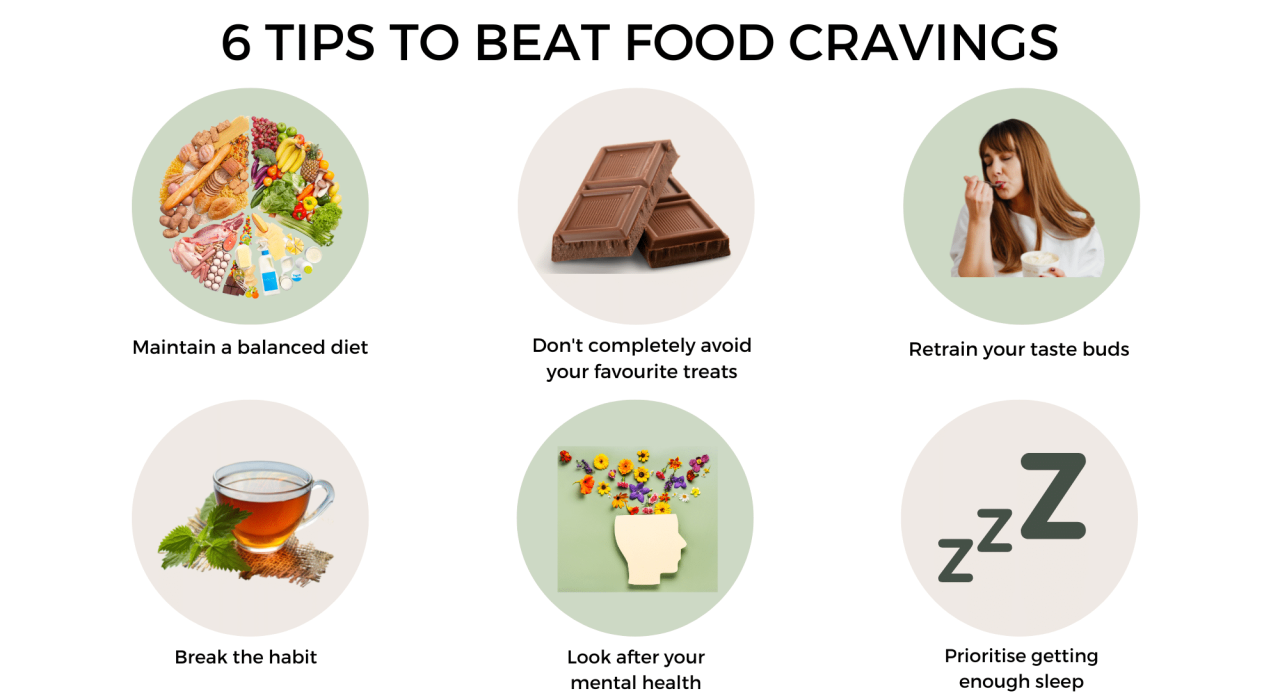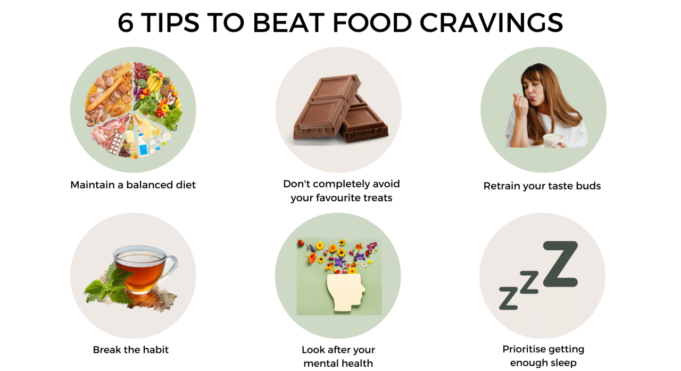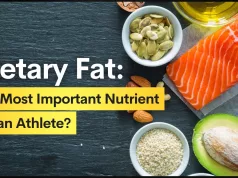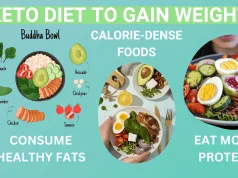Tips for avoiding cravings while on a diet – Conquer Cravings: Diet Tips That Actually Work – We’ve all been there: staring longingly at a plate of cookies, battling the urge to devour a whole pizza, or succumbing to the siren call of a chocolate bar. Cravings can be a major obstacle on the path to healthy eating, especially when you’re trying to stick to a diet.
But fear not, dear reader! This guide is your secret weapon against those pesky cravings, armed with tips and tricks to help you stay on track and reach your goals.
Think of it like this: cravings are like pesky mosquitos buzzing around your head, determined to ruin your perfectly good picnic. You can try to swat them away, but they just keep coming back. But what if you could learn to anticipate their arrival and create a plan to keep them at bay?
That’s where this guide comes in – we’ll explore the science behind cravings, equip you with practical strategies to manage them, and help you develop a long-term plan for craving prevention.
Understanding Cravings: Tips For Avoiding Cravings While On A Diet
Cravings are powerful urges to consume specific foods, often driven by a complex interplay of biological and psychological factors. They can be intensely tempting, making it challenging to stick to a diet. Understanding the mechanisms behind cravings is crucial for developing effective strategies to manage them.
Biological Factors
Our bodies are wired to crave certain foods due to their nutritional value and ability to provide energy. These cravings are often triggered by hormonal fluctuations and neurotransmitter activity.
Cravings are like those annoying relatives who show up unannounced, demanding your attention and tempting you with their delicious, sugary whispers. But don’t despair! A well-structured diet plan, like the one found on this website , can help you fuel your body with the right nutrients, leaving you feeling energized and less susceptible to those pesky cravings.
So, ditch the sugary temptations and embrace a healthier, happier you!
- Hormones:Hormones like ghrelin, known as the “hunger hormone,” stimulate appetite and cravings, particularly for high-calorie foods. Conversely, leptin, the “satiety hormone,” signals fullness and reduces cravings.
- Neurotransmitters:Neurotransmitters like dopamine, associated with pleasure and reward, play a significant role in cravings. Certain foods, especially those high in sugar and fat, stimulate dopamine release, creating a pleasurable experience that reinforces cravings.
Psychological Factors, Tips for avoiding cravings while on a diet
Beyond biological mechanisms, psychological factors also contribute significantly to cravings. These include emotional triggers, learned associations, and environmental cues.
- Emotional Triggers:Stress, boredom, anxiety, and sadness can trigger cravings as a coping mechanism. These emotions can lead to impulsive food choices, seeking comfort and temporary relief.
- Learned Associations:Cravings can be influenced by learned associations. For instance, if you always eat ice cream after a stressful day, your brain may associate ice cream with stress relief, leading to cravings in similar situations.
- Environmental Cues:Exposure to food cues, such as the smell of freshly baked cookies or the sight of tempting snacks, can trigger cravings. These cues can activate the reward centers in the brain, leading to an irresistible urge to eat.
Common Cravings and Their Potential Underlying Causes
Understanding the potential underlying causes of common cravings can provide valuable insights into managing them effectively.
- Sugar Cravings:Often linked to low blood sugar levels, stress, and hormonal fluctuations. Sugary foods provide a quick energy boost, which can be appealing when feeling tired or depleted.
- Salty Cravings:Can be triggered by dehydration, mineral deficiencies, and hormonal imbalances. Salt helps regulate fluid balance in the body, and cravings for salty foods can indicate a need for electrolyte replenishment.
- Carbs Cravings:Often associated with serotonin levels, a neurotransmitter linked to mood regulation. Carbohydrates can increase serotonin production, leading to feelings of relaxation and well-being, which can be especially appealing during stressful times.
Strategies for Avoiding Cravings
Cravings can be a major obstacle when you’re trying to stick to a diet. They can be intense and overwhelming, making it hard to resist temptation. But don’t worry, there are strategies you can employ to manage those pesky cravings and stay on track.
Practical Tips for Managing Cravings
The key to managing cravings is to be prepared. Here are some practical tips that can help:
| Strategy | Explanation | Example | Benefits |
|---|---|---|---|
| Distract Yourself | Engaging in activities that take your mind off of food can help you break the cycle of cravings. | Go for a walk, call a friend, read a book, or do a quick workout. | It can help you break the cycle of cravings and reduce the urge to eat. |
| Drink Water | Sometimes, thirst can be mistaken for hunger. Drinking water can help you feel full and reduce cravings. | Keep a water bottle with you and sip on it throughout the day. | It can help you feel full and reduce cravings. |
| Eat Regularly | Skipping meals can actually make cravings worse. Eating regular, balanced meals can help stabilize your blood sugar levels and prevent intense hunger pangs. | Aim for 3 meals and 1-2 snacks per day. | It can help you feel full and reduce cravings. |
| Identify Triggers | Knowing what triggers your cravings can help you avoid them. | For example, if you crave chocolate after dinner, try having a cup of herbal tea instead. | It can help you avoid situations that lead to cravings. |
The Importance of Meal Planning and Prepping
Meal planning and prepping can be a game-changer when it comes to managing cravings. By planning your meals in advance, you’re less likely to reach for unhealthy snacks when hunger strikes.
“If you fail to plan, you plan to fail.”
Benjamin Franklin
Exercise and Cravings
Regular exercise can actually help regulate hunger hormones and curb cravings. When you exercise, your body releases endorphins, which can help improve your mood and reduce stress, both of which can contribute to cravings.
Cravings are like those pesky relatives who show up uninvited – they’re annoying, but you can’t always avoid them. A good strategy is to keep your pantry stocked with healthy snacks and focus on filling your plate with nutrient-rich foods.
If you’re over 40 and looking to shed some pounds, check out this article on the Best diet for women over 40 to lose weight safely. It’s packed with tips for managing cravings and getting back in shape.
Remember, the key to conquering cravings is to outsmart them, not starve them!
Managing Cravings When They Arise
Cravings can strike at any moment, tempting you to abandon your diet. But don’t despair! There are effective strategies for managing these urges and staying on track.
Distraction Techniques
When a craving hits, it’s essential to distract yourself before it takes over. Engaging your mind and body can help you ride the wave of temptation.
- Engage in a physical activity:A brisk walk, a quick workout, or even a few minutes of stretching can divert your attention and boost your mood.
- Do something creative:Pick up a hobby you enjoy, like painting, writing, or playing an instrument.
- Engage in a mentally stimulating activity:Solve a puzzle, read a book, or catch up on your favorite TV show.
- Call a friend or family member:Talking to someone you trust can help you process your cravings and offer support.
- Distract yourself with a sensory experience:Enjoy a cup of tea, listen to your favorite music, or take a relaxing bath.
Mindful Eating Practices
Mindful eating is a powerful tool for managing cravings. By focusing on your food and eating experience, you can reduce impulsive urges and develop a healthier relationship with food.
Cravings are like those annoying relatives who show up unannounced, demanding attention and sugary snacks. But fear not, you can tame those cravings with a little planning and a healthy dose of distraction. The key is to keep your body satisfied and your mind engaged.
Check out this article on how to lose weight without feeling hungry and stay motivated for some great tips. Once you’ve got a solid strategy in place, you can conquer those cravings and finally enjoy the delicious freedom of a healthy lifestyle!
- Eat slowly and savor each bite:Pay attention to the flavors, textures, and aromas of your food.
- Focus on your hunger and fullness cues:Listen to your body’s signals and eat only when you’re truly hungry. Stop eating when you feel comfortably full.
- Avoid distractions while eating:Turn off the TV, put away your phone, and focus solely on your meal.
Seeking Support
Don’t be afraid to reach out for help when you’re struggling with cravings. Friends, family, and even therapists can provide valuable support and encouragement.
- Talk to a trusted friend or family member:Sharing your struggles can help you feel less alone and provide a sense of accountability.
- Join a support group:Connecting with others who are going through similar challenges can offer a sense of community and shared understanding.
- Consider working with a therapist:A therapist can help you address the underlying causes of your cravings and develop coping strategies.
Long-Term Strategies for Craving Prevention
Think of conquering cravings as a marathon, not a sprint. While quick fixes can help in the moment, long-term success requires a deeper understanding of your relationship with food and a shift in your overall approach. It’s about building sustainable habits that prevent cravings from hijacking your willpower in the first place.
Identifying and Addressing the Root Causes of Cravings
Cravings often stem from deeper needs beyond just a desire for a particular food. Identifying the root causes is crucial for long-term craving prevention.
- Emotional Eating:Stress, boredom, sadness, or loneliness can trigger cravings. Learning to manage these emotions through healthy coping mechanisms like exercise, journaling, or spending time with loved ones can help break the cycle of emotional eating.
- Nutritional Deficiencies:Cravings for specific foods, like sweets or salty snacks, can sometimes be your body’s way of signaling a lack of essential nutrients. Ensuring a balanced diet rich in fruits, vegetables, and whole grains can help address these underlying deficiencies.
- Habitual Eating Patterns:If you consistently eat at certain times or in specific situations, your body may come to expect those foods and trigger cravings. Breaking these habitual patterns by introducing variety and mindful eating practices can help reduce cravings.
- Sleep Deprivation:When you’re sleep-deprived, your body produces more of the hunger hormone ghrelin and less of the satiety hormone leptin, leading to increased cravings. Prioritizing sleep can help regulate your hormones and reduce cravings.
Building Healthy Habits and Developing a Positive Relationship with Food
The key to preventing cravings lies in building healthy habits that support a positive relationship with food.
- Mindful Eating:Pay attention to your hunger and fullness cues. Eat slowly, savor each bite, and be present in the experience of eating. This helps you identify true hunger versus emotional or habitual cravings.
- Regular Meal Timing:Eating regular meals and snacks throughout the day helps prevent blood sugar fluctuations and keeps cravings at bay. Skipping meals can backfire, making cravings more intense.
- Hydration:Often, thirst is mistaken for hunger. Drinking plenty of water throughout the day can help curb cravings and keep you feeling satisfied.
- Healthy Snacking:Keep nutritious snacks on hand to satisfy cravings in a healthy way. Choose options like fruits, vegetables, nuts, or yogurt.
- Meal Planning:Planning your meals and snacks in advance can help you make healthier choices and avoid impulsive decisions when cravings strike.
Last Word

So, the next time a craving hits, remember: you’re not alone. With a little understanding and a dash of willpower, you can conquer those cravings and emerge victorious in your quest for a healthier you. And hey, if you do happen to slip up, don’t beat yourself up! Just pick yourself up, dust yourself off, and get back on track.
We’re all in this together!
User Queries
What are some common triggers for cravings?
Cravings can be triggered by various factors, including stress, boredom, fatigue, hormonal fluctuations, and even the sight or smell of certain foods.
Can I really eat my way out of a craving?
While it’s tempting to give in to cravings, it’s often better to address the underlying cause or find a healthier alternative. Sometimes, simply distracting yourself or waiting it out can help.
How long does a craving typically last?
Cravings usually subside within 15-20 minutes. If you can manage to distract yourself or find a healthier alternative during this time, you’ll be less likely to give in.
























